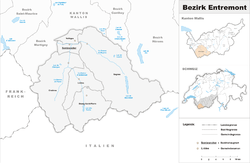Entremont (district)
| Entremont District d'Entremont | |
|---|---|
| District | |
 | |
| Country |
|
| Canton |
|
| Capital | Sembrancher |
| Area | |
| • Total | 633.2 km2 (244.5 sq mi) |
| Population (2015) | |
| • Total | 15,044 |
| • Density | 24/km2 (62/sq mi) |
| Time zone | CET (UTC+1) |
| • Summer (DST) | CEST (UTC+2) |
| Municipalities | 6 |
The district of Entremont is a district in the canton of Valais in Switzerland. It has a population of 15,044 (as of 31 December 2015).[1]
Municipalities
It comprises the following municipalities:
| Municipality | Population (31 December 2015)[1] |
Area km²[2] |
|---|---|---|
| Bagnes | 8,057 | 282.26 |
| Bourg-Saint-Pierre | 183 | 90.09 |
| Liddes | 750 | 60.16 |
| Orsières | 3,179 | 165.02 |
| Sembrancher | 984 | 17.63 |
| Vollèges | 1,891 | 17.87 |
| Total | 15,044 | 633.03 |
Coat of arms
The blazon of the municipal coat of arms is Azure, a Ram rampant Argent horned Or and langued and hoofed Gules, pierced by a sword Argent hilted Or, on four mounts Vert.[3]
Demographics
Entremont has a population (as of December 2015) of 15,044.[1] Most of the population (as of 2000) speaks French (11,149 or 91.9%) as their first language, Portuguese is the second most common (275 or 2.3%) and German is the third (201 or 1.7%). There are 122 people who speak Italian and 2 people who speak Romansh.[4]
As of 2008, the gender distribution of the population was 51.1% male and 48.9% female. The population was made up of 5,616 Swiss men (40.4% of the population) and 1,493 (10.7%) non-Swiss men. There were 5,590 Swiss women (40.2%) and 1,208 (8.7%) non-Swiss women.[5] Of the population in the district 7,166 or about 59.0% were born in Entremont and lived there in 2000. There were 1,721 or 14.2% who were born in the same canton, while 1,168 or 9.6% were born somewhere else in Switzerland, and 1,796 or 14.8% were born outside of Switzerland.[4]
As of 2000, there were 5,245 people who were single and never married in the district. There were 5,734 married individuals, 754 widows or widowers and 405 individuals who are divorced.[4]
There were 1,422 households that consist of only one person and 503 households with five or more people. Out of a total of 4,742 households that answered this question, 30.0% were households made up of just one person and there were 62 adults who lived with their parents. Of the rest of the households, there are 1,050 married couples without children, 1,652 married couples with children There were 250 single parents with a child or children. There were 94 households that were made up of unrelated people and 212 households that were made up of some sort of institution or another collective housing.[4][6]
The historical population is given in the following chart:[7]

Politics
In the 2007 federal election the most popular party was the CVP which received 51.76% of the vote. The next three most popular parties were the FDP (20.08%), the SVP (13.43%) and the SP (8.39%). In the federal election, a total of 5,031 votes were cast, and the voter turnout was 56.1%.[8]
In the 2009 Conseil d'Etat/Staatsrat election a total of 4,659 votes were cast, of which 231 or about 5.0% were invalid. The voter participation was 53.2%, which is similar to the cantonal average of 54.67%.[9] In the 2007 Swiss Council of States election a total of 4,931 votes were cast, of which 357 or about 7.2% were invalid. The voter participation was 56.4%, which is similar to the cantonal average of 59.88%.[10]
Religion
From the 2000 census, 10,194 or 84.0% were Roman Catholic, while 608 or 5.0% belonged to the Swiss Reformed Church. Of the rest of the population, there were 59 members of an Orthodox church (or about 0.49% of the population), there were 3 individuals (or about 0.02% of the population) who belonged to the Christian Catholic Church, and there were 57 individuals (or about 0.47% of the population) who belonged to another Christian church. There were 14 individuals (or about 0.12% of the population) who were Jewish, and 85 (or about 0.70% of the population) who were Islamic. There were 5 individuals who were Buddhist, 3 individuals who were Hindu and 9 individuals who belonged to another church. 630 (or about 5.19% of the population) belonged to no church, are agnostic or atheist, and 491 individuals (or about 4.05% of the population) did not answer the question.[4]
Education
In Entremont about 4,292 (35.4% of the population) have completed non-mandatory upper secondary education, and 1,107 (9.1%) have completed additional higher education (either University or a Fachhochschule). Of the 1,107 who completed tertiary schooling, 52.0% were Swiss men, 23.7% were Swiss women, 13.9% were non-Swiss men and 10.4% were non-Swiss women.[4]
References
- 1 2 3 Swiss Federal Statistical Office - STAT-TAB, online database – Ständige und nichtständige Wohnbevölkerung nach institutionellen Gliederungen, Geburtsort und Staatsangehörigkeit (German) accessed 30 August 2016
- ↑ Swiss Federal Statistical Office-Land Use Statistics 2009 data (German) accessed 25 March 2010
- ↑ Flags of the World.com accessed 24-August-2011
- 1 2 3 4 5 6 STAT-TAB Datenwürfel für Thema 40.3 - 2000 (German) accessed 2 February 2011
- ↑ Ständige Wohnbevolkerung nach Geschlecht und Heimat am 31.12.2009.xls (German) (French) accessed 24 August 2011
- ↑ Swiss Federal Statistical Office STAT-TAB - Datenwürfel für Thema 09.2 - Gebäude und Wohnungen (German) accessed 28 January 2011
- ↑ Swiss Federal Statistical Office STAT-TAB Bevölkerungsentwicklung nach Region, 1850-2000 (German) accessed 29 January 2011
- ↑ Swiss Federal Statistical Office, Nationalratswahlen 2007: Stärke der Parteien und Wahlbeteiligung, nach Gemeinden/Bezirk/Canton (German) accessed 28 May 2010
- ↑ Staatsratswahlen vom 1. März 2009 (German) accessed 24 August 2011
- ↑ Ständeratswahl 2007 (German) accessed 24 August 2011
Coordinates: 46°3′42″N 7°16′23″E / 46.06167°N 7.27306°E